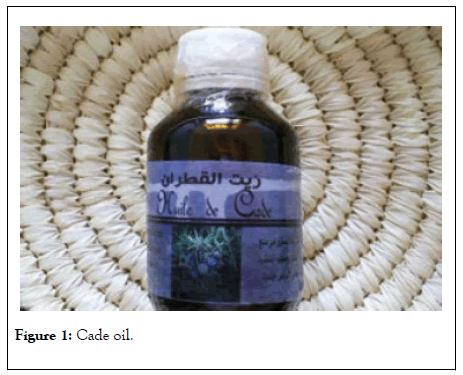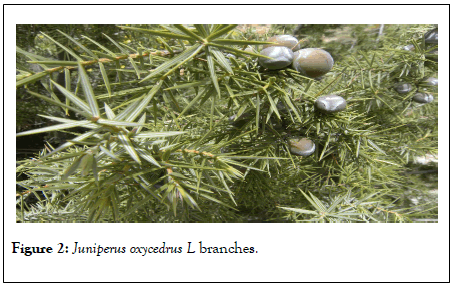
Journal of Clinical Toxicology
Open Access
ISSN: 2161-0495
+44 1478 350008

ISSN: 2161-0495
+44 1478 350008
Research Article - (2020)Volume 10, Issue 4
Introduction: Juniper tar "Cade oil" is distilled from the branches of Juniperus oxycedrus. Despite its known toxicity
and which is linked to a phenol content, this oil continues to be used in traditional medicine.
Materials and methods: We report the case of severe systemic toxicity after local administration of cade oil in an
infant.
Observation: This is a 12 month old infant; the youngest of three siblings from a well-followed pregnancy, vaginal
delivery, well vaccinated according to the national immunization program, with no particular pathological history.
Hospitalized in the pediatric resuscitation department for respiratory and neurological distress following poisoning
with cade oil, applied locally to the wrists, elbows forehead and head.
Conclusion: Juniper tar (cade oil) is one of the essential oils most used in traditional Moroccan medicine. Several
cases of intoxication have been recognized in the literature.
Renal Failure; Cade oil; Toxicity
Juniper tar also called cade oil;it is obtained by dry distillation from the branches Juniperus oxycedrus L. which is a Mediterranean species. It contains etheric oils, triterpene and phenols, used for many purposes in folk medicine and one of the essential oils most used in traditional Moroccan medicine (Figures 1 and 2).

Figure 1: Cade oil.

Figure 2: Juniperus oxycedrus L branches.
Poisoning is often of iatrogenic origin resulting mainly from the ingestion of a large amount or, particularly in infants and newcomers of prolonged and extensive skin application.
Phenol remains the most toxic component and probably responsible for the majority of the systemic symptoms observed during intoxication, affects a wide variety of systems, such as the central and peripheral nervous system, the cardiovascular, hepatic and biliary systems, skin and respiratory tract. Its absorption is rapid; its metabolism is mainly hepatic. The multivisceral systemic toxicity is explained by the formation of cytotoxic metabolites. The hydroxylation of phenols produces semi quinone radicals, the oxidation of which results in the formation of toxic free radicals when the amount ingested exceeds the capacities of hepatic conjugation [1].
We report the case of severe systemic toxicity after local administration of cade oil in an infant. This clinical case shows that the use of products can expose to a risk of poisoning confirming that the skin of the newborn can absorb various molecules with serious accidents.
It is a 12-month-old infant; the youngest of three siblings, from a well-followed pregnancy, vaginal delivery, well vaccinated according to the national immunization program, with no pathological history individuals. Hospitalized in the pediatric resuscitation department for respiratory and neurological distress following poisoning with cade oil, applied locally to the wrists, elbows forehead and head. The application was thick and extensive. An hour later, the infant presented respiratory distress, hypotonia, weak archaic reflexes see absent and convulsions without fever. On physical examination, the infant was unconscious, 75% desaturated under a high concentration mask with an impregnable blood pressure requiring intubation. The biological investigations revealed a renal insufficiency with 52 mg/l of creatinine plasma with a rate of urea to 3.5 g/l, a rate of potassium and sodium correct; metabolic acidosis (pH=7.28; HCO3=16 mmol/l and PCO2 at 32 mm Hg), absence of hepatic cytolysis, and all other laboratory tests were normal.
The treatment was mainly based on rapid and complete skin decontamination; it is done with soapy water, in all the contaminated regions to reduce the skin absorption of oil. For systemic intoxication, the therapeutic management is mainly symptomatic, mainly based on: Intubation and assisted ventilation, Administration of anticonvulsant, Correction of hemodynamic and acid-base disorders, and rehydration for renal failure.
All over Morocco, cade oil is widely used externally, in dermatology and in hair care. In folk medicine, it is used in local application in a certain number of skin disorders (psoriasis and eczema, wounds rebellious to the usual treatments, scabies, alopecia, hair loss, ...) and as a parasiticide and antiseptic. It is also used in the preparation of a number of cosmetic products (soap, cream, shampoo, etc.). Orally, a few drops are administered as a dewormer. According to Bellakhdar et al. [2], cade oil is also known for its prophylactic properties. Thus, in rural areas to ward off various epidemics, it is advisable for the population to apply a drop of tar of oxycedra on the nose; it is also in this sense that we coat with this tar the bottom of the water jars, the jugs and inside the guerba (skin beams).
Phenol is the most toxic component and responsible for the majority of the systemic symptoms observed in our case. Its absorption is rapid and its metabolism is mainly hepatic. The hydroxylation of phenols produces semi quinone radicals, the oxidation of which results in the formation of toxic free radicals when the amount ingested exceeds the capacities of hepatic conjugation [1].
Renal and hepatic toxicities are the well-known characteristics of the toxicity of phenols. Hashimoto et al. [3], observed elevations in aminotransferases (AST 10,450 IU/l, ALT 8,990 IU/l), LDH (15,580 IU/l) and creatine kinase (170 IU/l) after 24 h ingestion of approximately 70 ml of a 50% cresol solution in a 26-year-old woman who was initially asymptomatic. It has been observed that liver enzyme levels have returned to baseline within 3 months. In our patient, the liver enzymes remained normal.
We also observed acute renal failure in our patient. Koruk et al. [4], reported the presence of renal insufficiency (urea=114 mg/dl, serum creatinine=4.7 mg/dl) in a man who ingested a spoonful of Juniperus oxycedrus extract in order to heal his nephrolithiasis.
Wu et al. [5], reported that in a 44-year-old man, acute renal failure, mild gastrointestinal injury and pneumonia occurred following an intentional ingestion of 150 g of cresol.
The clinical characteristics of our patient were similar to those reported in the literature following exposure to phenol.
Juniper tar (cade oil) is one of the most used essential oils in traditional Moroccan medicine. Several cases of intoxication have been described in the literature.
Citation: Ezzaki IFS, Mtioui N, Khayat SE, Medkouri G, Zamed M, Ramdani MB (2020) Acute Renal Failure Following Poisoning by Juniper Tar (Cade Oil). J Clin Toxicol. 10:442. DOI: 10.35248/2161-0495.20.10.442
Received: 26-May-2020 Accepted: 09-Jun-2020 Published: 16-Jun-2020 , DOI: 10.35248/2161-0495.20.10.442
Copyright: © 2020 Ezzaki IFS, et al. This is an open-access article distributed under the terms of the Creative Commons Attribution License, which permits unrestricted use, distribution, and reproduction in any medium, provided the original author and source are credited.